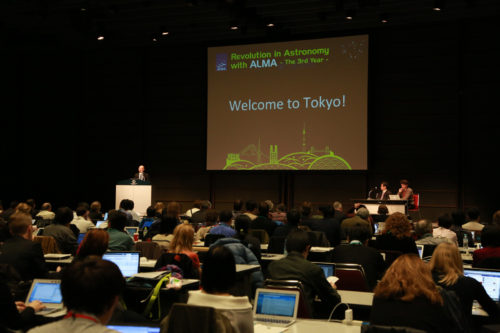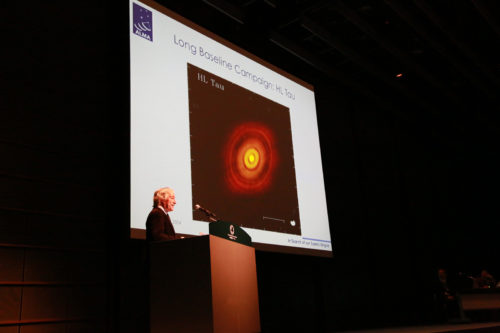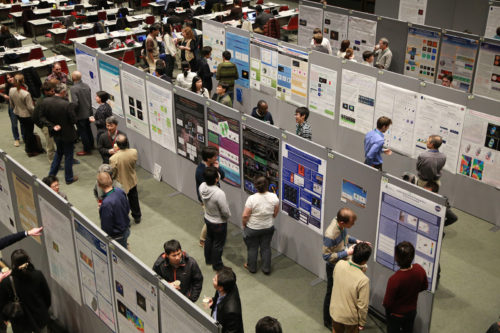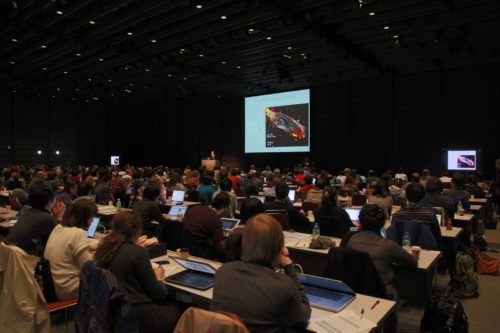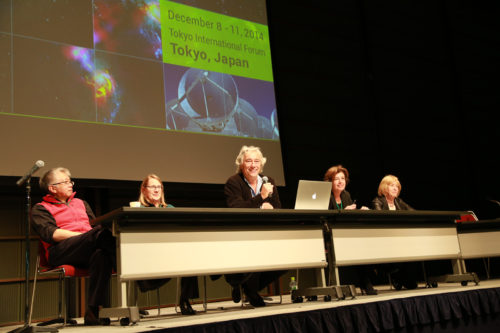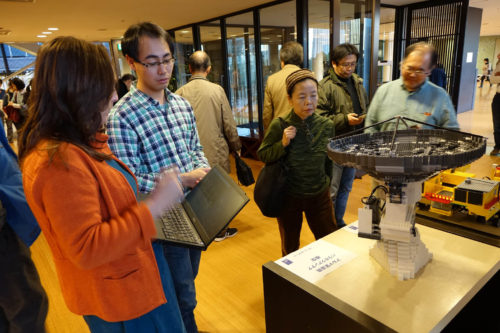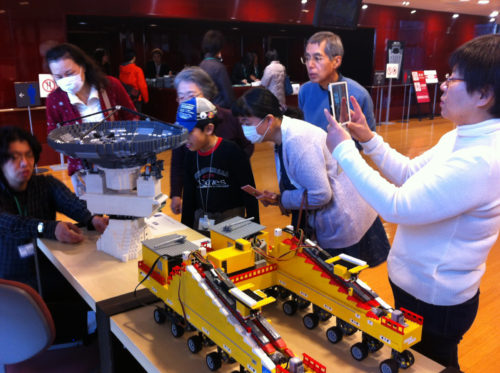Astronomers from around the world meet to share remarkable results from ALMA observations
Astronomers from around the world met in Japan to discuss the exciting scientific results from the Atacama Large Millimeter/submillimeter Array (ALMA) radio telescope. ALMA began Early Science operations in late September 2011 and around 170 papers based on its findings have been published in refereed journals since then.
"This conference has confirmed that ALMA has started a revolution in astronomy," —said Ken Tatematsu, Chair of the Scientific Organizing Committee—. "With unprecedented spatial resolution and sensitivity, ALMA is producing many breath-taking results as how galaxies formed after the Big Bang, how planets form from disks around protostars, and what kind of prebiotic molecules exist in the Universe," he added.
From December 8 to 11, around 300 astronomers from different regions met in Tokyo for the “Revolution in Astronomy with ALMA – The 3rd Year” conference sponsored by ALMA partners ESO, NAOJ and NRAO, as well as the Joint ALMA Observatory.
Credit: ALMA (ESO/NAOJ/NRAO), M.Hiramatsu
The conference covered all of the ALMA science topics, from observations of the Solar System, formation of stars and planets, galaxies and stellar evolution to understanding the astrochemistry of the Universe. Presentations, posters and discussions focused on the data being collected by the ALMA radio telescope and the detailed images it has provided, which are leading astronomers to question previous scientific models.
"We are witnessing many transformational scientific results thanks to this new instrument," said ALMA Director Pierre Cox. "With the completion of construction last September, ALMA is now in full operation, delivering many wonderful results and making a dream come true."
While still under construction, ALMA began its Early Science observations in September 2011 with just a quarter of its capability, or about 16 antennas. Since then, ALMA has almost triple the number of antennas (45 for the current cycle) and quadrupled the number of hours available for the science community (to 2,000 hours). This has resulted in a total of 3,505 observation proposals being granted by ALMA since the beginning of the Early Science.
Credit: ALMA (ESO/NAOJ/NRAO), M.Hiramatsu
ALMA recently finished its Long Baseline Campaign, which tested the array in the most extended configuration yet (antennas 15 kilometers apart), boosting the ability of the radio telescope to capture fine detail and allowing astronomers to uncover much more information about objects observed in the Universe. As a result of these developments ALMA has recently published the most detailed image obtained of the disc structure around HL Tau (link), a million-year-old, Sun-like star. This image was featured in the media around the world and shared during this conference.
"We are pleased to host so many astronomers in central Tokyo from all around the world," said Daisuke Iono, Chair of the Local Organization Committee. "The participants are enjoying the latest ALMA results, Japanese cuisine and the local culture."
On December 7, before the start of the conference, a public lecture on ALMA’s pioneering results was given at the Tokyo International Exchange Center by Ewine van Dishoeck (Professor at Leiden Observatory/ Max Planck Institute of Extraterrestrial Physics), Tetsuo Hasegawa (Professor, Director of NAOJ Chile Observatory) and Yasuo Fukui (Professor at Nagoya University). The new information and robotic models of an ALMA antenna and transporter made of Lego bricks delighted the children and adults who attended the lecture (see image).
Credit: ALMA (ESO/NAOJ/NRAO), S.Nukatani
More Information
The Atacama Large Millimeter/submillimeter Array (ALMA), an international astronomy facility, is a partnership of the European Organisation for Astronomical Research in the Southern Hemisphere (ESO), the U.S. National Science Foundation (NSF) and the National Institutes of Natural Sciences (NINS) of Japan in cooperation with the Republic of Chile. ALMA is funded by ESO on behalf of its Member States, by NSF in cooperation with the National Research Council of Canada (NRC) and the National Science Council of Taiwan (NSC) and by NINS in cooperation with the Academia Sinica (AS) in Taiwan and the Korea Astronomy and Space Science Institute (KASI).
ALMA construction and operations are led by ESO on behalf of its Member States; by the National Radio Astronomy Observatory (NRAO), managed by Associated Universities, Inc. (AUI), on behalf of North America; and by the National Astronomical Observatory of Japan (NAOJ) on behalf of East Asia. The Joint ALMA Observatory (JAO) provides the unified leadership and management of the construction, commissioning and operation of ALMA.
Contact:
Nicolás Lira
Education and Public Outreach Assistant
Joint ALMA Observatory
Santiago, Chile
Tel: +56 2 467 6519
Cell: +56 9 9445 7726
Email: [email protected]


